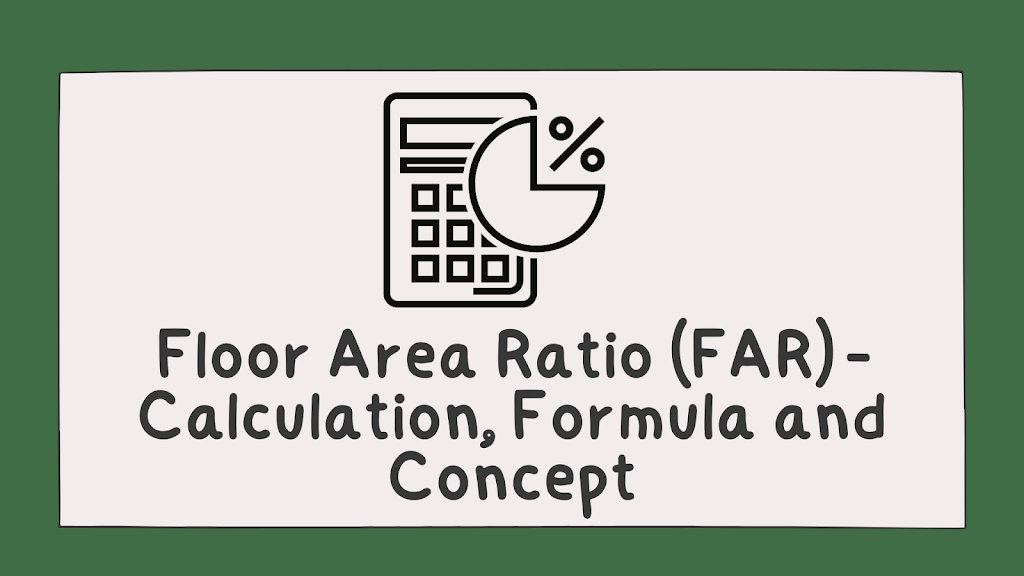
Whenever you want to construct a building on a plot. So can you make an unlimited floor on it? Or can you make it as tall as you want? Or can you cover that plot 100%? We will get the answer to all these questions If we will find out what the floor area ratio is?
 |
| Floor Area Ratio (FAR) – Calculation, Formula and Concept |
In this artical, I will talk to you in detail about what is floor area ratio? How is its calculation done? What is the difference between floor area ratio and floor space index? How is the floor area of any place decided? On what factors does it depend upon?
So I would request you to watch the video from the start till the end. So that this concept will be clear to you at once. So let’s go straight towards the blackboard. So in this video, we will know What floor area ratio is? Whenever you want to construct a building on any plot How much-covered area can you make it? Total covered area This is determined by the floor area ratio.
So, FAR of any locality or any city You don’t have to calculate it Generally, it is fixed by the government The urban planning department fixes it. On what factors does it depend upon? We will know about this too in detail But before that, we will understand the concept of floor area ratio. So the definition of the floor area ratio is that It is the area of building’s total covered area to the size of the plot on which it is built. So if we see the formula then the total covered area of any building Adding all the floors If you divide it by the size of the plot Then you will get FAR So we will understand this by an example.
Assume there are four floors in any building And the size of every floor is 5000 square feet and the total area of the plot is 10000 square feet then your FAR would be 2 And it is denoted as a percentage in some places. So it can be 200 % also Which is also written as 200 in short at many places So if there is FAR of 200 at some places Then it means their ratio is 2 So you can make 2 times the covered area on your plot.
Assume the FAR is 150 somewhere That means the ratio there is 1.5 You can make 1.5 the covered area there So we will understand this with example Assume FAR of someplace is 50 So you have many options in that For example, assume the area of the plot is 10000 Square feet. So in this case you leave 50% place idle. You left 5000 Square feet vacant And you build a single-store in 5000 Square feet Then your FAR would be 5000 square feet of built-up space. divided by 10,000 Square feet of the total plot area.
So it will be 0.5 or 50% So you also have another option You can leave 75% space Assume you left 7500 Square feet of space vacant And in 2500 square feet You made two stories then also your FAR would be 2500×2/10000 Then also your FAR would be 50% Or if we see another example Assume your FAR is 200 In this case, if you want to make 100% Then it will be 10000 Square feet of built-up space × 2, then your FAR would be 10000×2 / 10000 Square feet of the plot area.
Then it would be equal to the area of two plots again FAR would be 200% So you have another option in this That assume 5000 Square feet is left vacant and in the remaining 50% 5000 square feet×4(if you make 4 stories) Then also your FAR would be 5000×4/10000 That will be 2 FAR That means it will be 200% FAR So the question that arises is FAR is calculated. But, you don’t have to calculate FAR It is fixed by the government The main purpose of FAR is to calculate the total covered area Assume you know the FAR of someplace And you know the total area of your plot Then how much can you make your total covered area? of building. You will know this easily.
For example, If the FAR of that area is 2 And the area of the plot is 10000 square feet Then you can make a total covered area of 20000 Square feet The total covered area of 20000 Square feet It’s not necessary that you can make it by covering two floors 100% Because you have to follow other regulations in this How much setback is to be left? Some space should be left at the front Some space should be left for the parking So all these regulations are there.
Some high restrictions are there. We will know about some of these regulations too Before that, I want to tell you about the comparison of FAR and with that FSI So FAR is Floor Area Ratio and there is one more term whose meaning is also the same. That is the Floor Space Index. The full form of FSI is Floor Space Index So FSI and FAR have the same formula. FSI is also a total covered area divided by the plot. but there is a difference in denotation FAR is denoted as a percentage. For example in Delhi FAR term is used So the FAR in Delhi varies from 120 to 400 So in a way it becomes 120% to 400% And FSI is the plain index number For example in Bangalore FSI is used And the FSI of Bangalore varies from 1.75 to 3.35 So the higher FSI or higher FAR FAR or FSI is kept high at places where infrastructure is quite good and the population is high. I think you have got an idea of the floor area ratio.
How is it calculated? How is it compared to FSI? Now we will learn the other regulations which you have to follow other FAR When you construct a building As I have told you, you have to follow FAR and FSI of every area Along with this, you may have to leave some space in front or back Which is called a setback. So you have to see these requirements How much area can you cover In the total ground There is a regulation for this also. Assume you want to leave some space for the parking. Or there are restrictions for height at some places. So you have to follow all these regulations.
Now we will learn how the government decides the floor area ratio. So the floor area ratio depends on two or three factors In that one factor is the current population of the city or locality. Assume the population of any area is very high then the floor area ratio Assume the population is high then the floor area ratio is increased there What happens there is Vertical development is promoted Vertical development Assume at someplace, population growth is high Assume the current population is less but population growth is high Jobs are created due to industrialization. Then the government can increase the FAR there.
And the FAR also depends upon the infrastructure. Assume the infrastructure of any place is quite good then the FAR can be increased there. But if the infrastructure is less Then the government keeps the low FAR there. So if say it in a nutshell When the FAR of any place increases Then the population density gets increased Population density. That means more people will live in less area Stress will be caused on more infrastructure. Whenever the government increases FAR Then it is necessary to increase the infrastructure as well Otherwise, stress is caused by your transportation network or power or water.
So when FAR is increased The population density also increases And along with that, vertical development is also promoted when FAR increases If you liked this video then like and share the video You can also give your suggestions in the comment section And if you haven’t subscribed to the channel yet then subscribe And press the bell icon Because I keep coming up with interesting videos related to finance and investment So let’s meet in the next video. Till then keep learning, keep earning, and be happy



